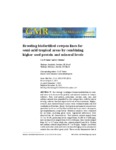Please use this identifier to cite or link to this item:
http://www.alice.cnptia.embrapa.br/alice/handle/doc/982700| Title: | Breeding biofortified cowpea lines for semi-arid tropical areas by combining higher seed protein and mineral levels. |
| Authors: | SANTOS, C. A. F.  BOITEUX, L. S.   |
| Date Issued: | 2013 |
| Citation: | Genetics and Molecular Research, v. 12, n. 4, p. 6782-6789, 2013. |
| Description: | One strategy to mitigate human malnutrition in semi-arid areas is to increase the protein and mineral content of cowpea cultivars. Total seed protein, potassium, calcium, iron, zinc, and sodium contents were quantified in elite cowpea lines, with the aim to develop cultivars that had improved levels of these nutrients. Eighty-seven F6 lines derived from 6 crosses were evaluated under rain-fed conditions in Petrolina, Brazil. Seed protein and mineral content were quantified by the micro-Kjeldhal method and in an atomic absorption spectrophotometer, respectively. Statistical analyses were estimated for all traits, including grain yield. Significant differences were observed for all characteristics. Seed protein content ranged from 22.5 to 34.1%, potassium levels ranged from 20,200 to 27,000 ppm, and calcium levels ranged from 410 to 6260 ppm. Iron content ranged from 36.5 to 137 ppm, while zinc content ranged from 36 to 58 ppm and sodium content ranged from 29.2 to 88 ppm. Simple correlation coefficient values indicated that selection for high protein and mineral content does not affect grain yield. These results demonstrate that it higher levels of protein and essential minerals. |
| Thesagro: | Feijão Nutrição humana Semente Proteína |
| Keywords: | Cultivares Feijão-caupi Linhas de feijão-caupi biofortificados Semiárido |
| ISSN: | 1676-5680 |
| Type of Material: | Artigo de periódico |
| Access: | openAccess |
| Appears in Collections: | Artigo em periódico indexado (CNPH)  |
Files in This Item:
| File | Description | Size | Format | |
|---|---|---|---|---|
| GMR124678267892013.pdf | 301,68 kB | Adobe PDF |  View/Open |









